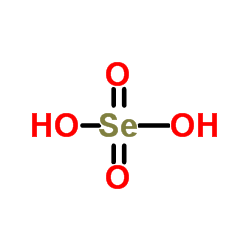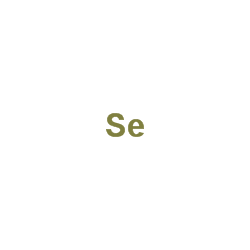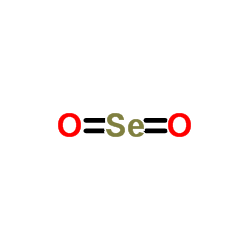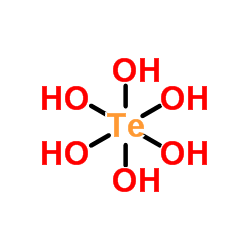7783-00-8
| Name | selenous acid |
|---|---|
| Synonyms |
Monohydrated selenium dioxide
Selenium dioxide,monohydrated EINECS 231-974-7 selenic(IV) acid seleniums acid EINECS 231-957-4 MFCD00134090 Selenious acid (H2SeO3) selenious acid |
| Density | 4.81 g/mL at 25ºC(lit.) |
|---|---|
| Boiling Point | 684.9ºC(lit.) |
| Melting Point | 70ºC |
| Molecular Formula | H2O3Se |
| Molecular Weight | 128.97400 |
| Flash Point | 690°C |
| Exact Mass | 129.91700 |
| PSA | 57.53000 |
| Appearance | powder |
| Storage condition | Store at RT. |
| Stability | Stable. |
| Water Solubility | H2O: soluble | 167 g/100 mL (20 ºC) |
Synonym:Monohydrated selenium dioxide; selenous acid Section 2 - COMPOSITION, INFORMATION ON INGREDIENTS
Risk Phrases: 23/25 33 50/53 Section 3 - HAZARDS IDENTIFICATION EMERGENCY OVERVIEW
Toxic by inhalation and if swallowed. Danger of cumulative effects. Very toxic to aquatic organisms, may cause long-term adverse effects in the aquatic environment.Hygroscopic (absorbs moisture from the air). Potential Health Effects Eye: May cause severe eye irritation. May result in corneal injury. Skin: May cause severe skin irritation. May be absorbed through the skin in harmful amounts. Prolonged and/or repeated contact may cause irritation and/or dermatitis. Ingestion: May be fatal if swallowed. May cause liver and kidney damage. May cause burns to the digestive tract. Inhalation: May be fatal if inhaled. May cause severe irritation of the respiratory tract with sore throat, coughing, shortness of breath and delayed lung edema. Chronic: Symptoms demonstrated by humans suffering from chronic selenium intoxication, selenosis, include depression, languor, nervousness, dermatitis, gastrointestinal disturbances, giddiness, garlic odor of the breath and sweat, moderate emotional instability, excess dental caries, and in extreme cases, loss of fingernails and partial alopecia (hair loss). Section 4 - FIRST AID MEASURES Eyes: In case of contact, immediately flush eyes with plenty of water for at least 15 minutes. Get medical aid immediately. Skin: In case of contact, immediately flush skin with plenty of water for at least 15 minutes while removing contaminated clothing and shoes. Get medical aid immediately. Wash clothing before reuse. Ingestion: POISON material. If swallowed, get medical aid immediately. Only induce vomiting if directed to do so by medical personnel. Never give anything by mouth to an unconscious person. Inhalation: POISON material. If inhaled, get medical aid immediately. Remove victim to fresh air. If not breathing, give artificial respiration. If breathing is difficult, give oxygen. Notes to Physician: Section 5 - FIRE FIGHTING MEASURES General Information: As in any fire, wear a self-contained breathing apparatus in pressure-demand, MSHA/NIOSH (approved or equivalent), and full protective gear. Extinguishing Media: Use extinguishing media most appropriate for the surrounding fire. Section 6 - ACCIDENTAL RELEASE MEASURES General Information: Use proper personal protective equipment as indicated in Section 8. Spills/Leaks: Vacuum or sweep up material and place into a suitable disposal container. Avoid generating dusty conditions. Provide ventilation. Section 7 - HANDLING and STORAGE Handling: Wash thoroughly after handling. Remove contaminated clothing and wash before reuse. Minimize dust generation and accumulation. Do not breathe dust, vapor, mist, or gas. Do not get in eyes, on skin, or on clothing. Do not ingest or inhale. Use only with adequate ventilation or respiratory protection. Storage: Store in a cool, dry place. Store in a tightly closed container. Poison room locked. Section 8 - EXPOSURE CONTROLS, PERSONAL PROTECTION Engineering Controls: Facilities storing or utilizing this material should be equipped with an eyewash facility and a safety shower. Use adequate general or local exhaust ventilation to keep airborne concentrations below the permissible exposure limits. Use process enclosure, local exhaust ventilation, or other engineering controls to control airborne levels. Exposure Limits CAS# 7783-00-8: United Kingdom, WEL - TWA: (listed as selenium compounds): 0.1 mg TWA (except hydrogen selenide, as Se) United Kingdom, WEL - STEL: (listed as selenium compounds): 0.3 m STEL (except hydrogen selenide, as Se) United States OSHA: 0.2 mg/m3 TWA (as Se) (listed under Selenium compounds). Belgium - TWA: (listed as selenium compounds): 0.2 mg/m3 VLE (as Japan: (listed as selenium compounds): 0.1 mg/m3 OEL (except SeH2 SeF6, as Se) Malaysia: (listed as selenium compounds): 0.2 mg/m3 TWA (as Se) Netherlands: (listed as selenium compounds): 0.1 mg/m3 MAC (as Se Spain: (listed as selenium compounds): 0.1 mg/m3 VLA-ED (except hydrogen selenide, as Se) Personal Protective Equipment Eyes: Wear chemical splash goggles. Skin: Wear appropriate protective gloves to prevent skin exposure. Clothing: Wear appropriate protective clothing to prevent skin exposure. Respirators: Follow the OSHA respirator regulations found in 29 CFR 1910.134 or European Standard EN 149. Use a NIOSH/MSHA or European Standard EN 149 approved respirator if exposure limits are exceeded or if irritation or other symptoms are experienced. Section 9 - PHYSICAL AND CHEMICAL PROPERTIES Physical State: Powder Color: white Odor: Not available. pH: Not available. Vapor Pressure: Not available. Viscosity: Not available. Boiling Point: Not available. Freezing/Melting Point: 70 deg C (dec) Autoignition Temperature: Not applicable. Flash Point: Not applicable. Explosion Limits, lower: Not available. Explosion Limits, upper: Not available. Decomposition Temperature: 70 deg C Solubility in water: Readily soluble in water Specific Gravity/Density: Not available. Molecular Formula: H2SeO3 Molecular Weight: 128.97 Section 10 - STABILITY AND REACTIVITY Chemical Stability: Stable under normal temperatures and pressures. Conditions to Avoid: Dust generation, moisture, excess heat. Incompatibilities with Other Materials: Strong reducing agents, finely powdered metals. Hazardous Decomposition Products: Selenium/selenium oxides. Hazardous Polymerization: Will not occur. Section 11 - TOXICOLOGICAL INFORMATION RTECS#: CAS# 7783-00-8: VS7175000 LD50/LC50: Not available. Oral rat LDLo: 25 mg/kg. Carcinogenicity: Selenious acid - Not listed by ACGIH, IARC, or NTP. Other: See actual entry in RTECS for complete information. Section 12 - ECOLOGICAL INFORMATION Other No information available. Section 13 - DISPOSAL CONSIDERATIONS Dispose of in a manner consistent with federal, state, and local regulations. Section 14 - TRANSPORT INFORMATION IATA Shipping Name: SELENIUM COMPOUND, N.O.S. Hazard Class: 6.1 UN Number: 3283 Packing Group: II IMO Shipping Name: SELENIUM COMPOUND, N.O.S. Hazard Class: 6.1 UN Number: 3283 Packing Group: II RID/ADR Shipping Name: SELENIUM COMPOUND, N.O.S. Hazard Class: 6.1 UN Number: 3283 Packing group: II USA RQ: CAS# 7783-00-8: 10 lb final RQ; 4.54 kg final RQ Section 15 - REGULATORY INFORMATION European/International Regulations European Labeling in Accordance with EC Directives Hazard Symbols: T N Risk Phrases: R 23/25 Toxic by inhalation and if swallowed. R 33 Danger of cumulative effects. R 50/53 Very toxic to aquatic organisms, may cause long-term adverse effects in the aquatic environment. Safety Phrases: S 20/21 When using do not eat, drink or smoke. S 28A After contact with skin, wash immediately with plenty of water. S 45 In case of accident or if you feel unwell, seek medical advice immediately (show the label where possible). S 60 This material and its container must be disposed of as hazardous waste. S 61 Avoid release to the environment. Refer to special instructions/safety data sheets. WGK (Water Danger/Protection) CAS# 7783-00-8: No information available. Canada CAS# 7783-00-8 is listed on Canada's DSL List. CAS# 7783-00-8 is listed on Canada's Ingredient Disclosure List. US FEDERAL TSCA CAS# 7783-00-8 is listed on the TSCA inventory. SECTION 16 - ADDITIONAL INFORMATION N/A |
CHEMICAL IDENTIFICATION
HEALTH HAZARD DATAACUTE TOXICITY DATA
MUTATION DATA
|
| Symbol |



GHS06, GHS08, GHS09 |
|---|---|
| Signal Word | Danger |
| Hazard Statements | H301 + H331-H373-H410 |
| Precautionary Statements | P261-P273-P301 + P310-P311-P501 |
| Personal Protective Equipment | Eyeshields;Faceshields;Gloves;type P2 (EN 143) respirator cartridges |
| Hazard Codes | T:Toxic;N:Dangerousfortheenvironment; |
| Risk Phrases | R23/25;R33;R50/53 |
| Safety Phrases | S20/21-S28-S45-S60-S61 |
| RIDADR | UN 2811/2630/3283 |
| WGK Germany | 3 |
| RTECS | VS7700000 |
| Packaging Group | III |
| Precursor 10 | |
|---|---|
| DownStream 10 | |
















